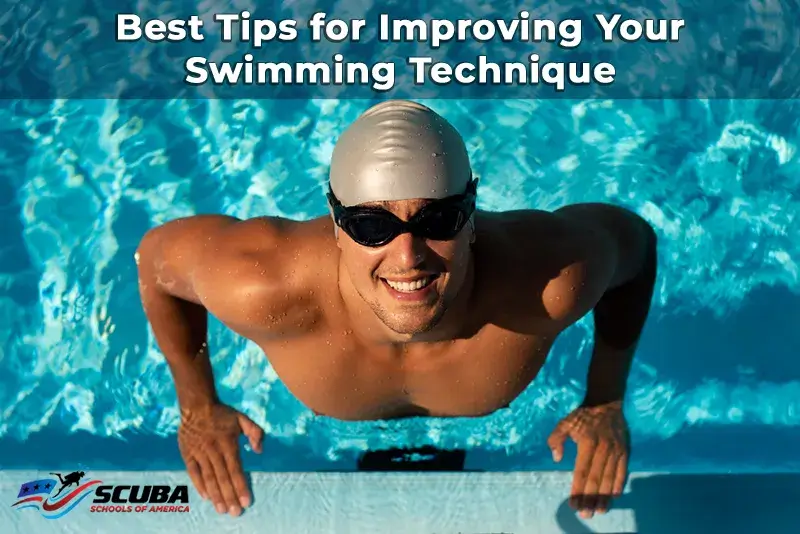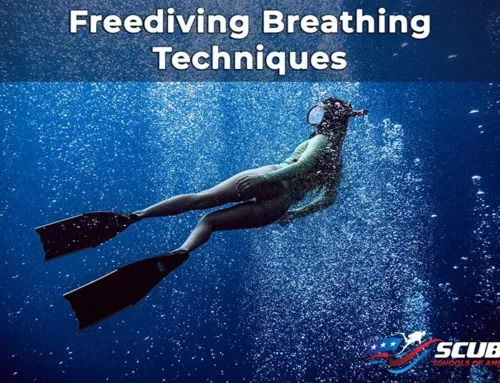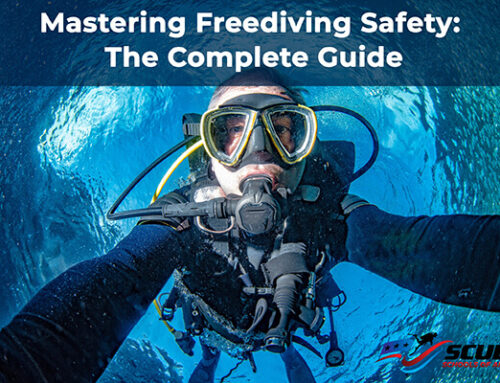The Importance of Swimming Technique: A Key to Safety and Enjoyment
Mastering proper swimming techniques is essential for moving through the water with efficiency, confidence, and ease. Whether you’re training for competitive swimming, exploring underwater worlds as a scuba diver, or simply taking a refreshing dip in a summer lake, a strong swimming technique ensures not only safety but also greater enjoyment.
By focusing on the fundamentals of swimming technique, you can enhance your performance, conserve energy, and make your time in the water more rewarding.
Beyond recreation, the swimming technique is a life-saving skill. Knowing how to swim properly equips you with the ability to navigate water safely during activities such as kayaking, surfing, or paddleboarding.
Swimming techniques can make all the difference in handling unexpected situations, giving you the confidence to enjoy aquatic activities without fear.
For those new to swimming, the idea of learning can feel overwhelming. However, by focusing on improving your swimming technique step by step, the process becomes much less intimidating. With consistent practice and the right guidance, developing a good swimming technique transforms swimming from a daunting challenge to an enjoyable and natural activity.
Swimming is not only fun but also an incredible full-body workout. A proper swimming technique allows your body to work effectively against water resistance, strengthening muscles, improving cardiovascular health, and boosting lung capacity. Whether for fitness, safety, or leisure, refining your swimming technique can open up a world of opportunities in the water, making every stroke and splash worthwhile.
Best Swimming Techniques
Swimming is a versatile and essential life skill that offers numerous physical and recreational benefits.
At Scuba Schools of America, we emphasize the importance of mastering fundamental swimming techniques, which include breaststroke, backstroke, and front crawl. These strokes cater to swimmers of all levels, allowing for personalized learning and skill enhancement.
Our expert instructors create a supportive environment where students can build confidence, improve technique, and enjoy the water while gaining lifelong swimming skills.
Whether you’re looking to perfect your strokes or simply feel safer in the water, our swim lessons provide the foundation for a lifetime of aquatic enjoyment and safety.
Breaststroke
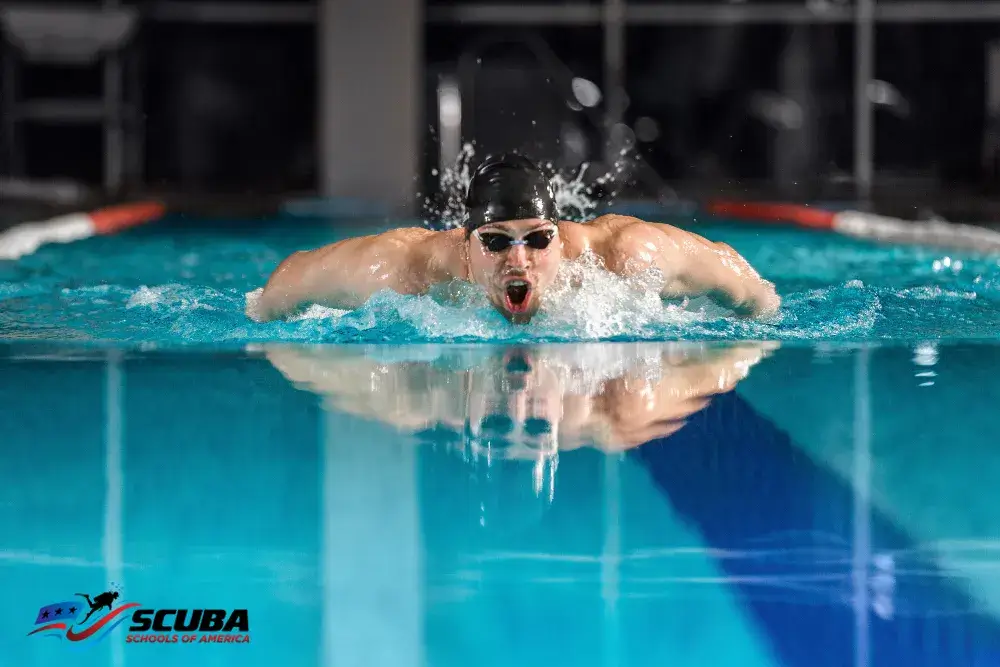
The breaststroke is ideal for beginners due to its straightforward rhythm and controlled movements. This stroke involves extending the arms forward with hands together while the head remains submerged. The legs are positioned straight behind the body, feet together. To execute the stroke:
- The arms move outward at the surface, pulling down and back.
- As the arms pull, the head briefly lifts above water for inhalation before exhaling underwater.
- Simultaneously, the feet draw toward the buttocks, then kick outward, downward, and back together, propelling the swimmer forward.
Known as one of the oldest swimming strokes, breaststroke is used for lifesaving, recreational swimming, and competitive purposes. Its effectiveness in rough water and low-energy demand makes it a versatile choice. Historically, the breaststroke has been likened to a frog’s movement due to the characteristic “frog kick.” Over time, competitive adaptations, such as eliminating the glide phase and adjusting breathing techniques, have made the stroke more efficient.
Breaststroke is most effective in calm water and is characterized by a slower pace and reduced energy exertion, making it a relaxing option for many swimmers.
How to Swim Breaststroke
Maximizing your efficiency in the pool starts with refining your breaststroke technique. Here are some advanced tips to help you enhance your performance and make the most of your time in the water.
Body Position in the Water
- Keep your head facing forward, aligned with your body for a streamlined position.
- Maintain your shoulders, hips, and legs as horizontal as possible, with a slight slope to allow your leg kick to remain beneath the water.
- Engage your core and abdominal muscles to prevent your hips from dropping. Your legs should extend directly behind you, not below.
- Relax your neck and shoulders to facilitate smooth arm movements and minimize strain. When gliding, look downward to avoid overextending your neck.
Arm Movements
- Keep your elbows high as you move your hands outward and around in a sculling motion.
- Sweep your hands inward toward your upper chest as though they are about to meet.
- Avoid sweeping your arms too wide; remember that most of your propulsion comes from your leg movements, not your arms.
Leg Movements
- Unlike the front crawl, the breaststroke relies heavily on the power of the leg kick for propulsion.
- Position your knees slightly wider than hip-width apart, angled slightly outward but aligned behind your hips.
- As you kick, turn your feet outward and sweep them backward in a circular motion. Keep your feet flexed rather than loose.
- Finish your kick with your legs together, extended in a streamlined position, with toes pointed slightly inward.
- During the recovery phase, bring your heels toward your seat, ensuring the soles of your feet face outward. Focus on pulling your feet toward your bum instead of drawing your knees toward your chest.
By paying attention to these finer details and practicing consistently, you can develop a more powerful and efficient breaststroke, enhancing both speed and stamina in the water.
Backstroke
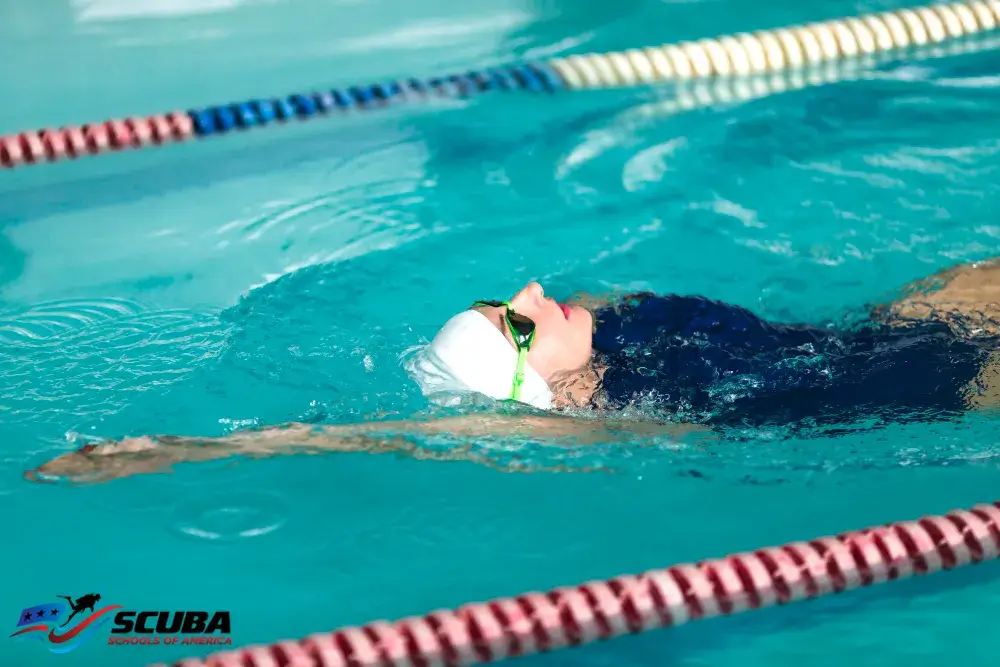
The backstroke, developed in the early 20th century, features a supine position where the swimmer lies flat on their back, maintaining a streamlined posture. Key movements include:
- Alternating arm motions: one arm reaches above the head, entering the water in line with the shoulders, palm outward, and the little finger enters first. The arm then pulls back to the thigh.
- A slight body roll accompanies the arm movements.
- The kick evolved from a frog kick to an up-and-down flutter kick similar to the front crawl.
Primarily a competitive stroke, the backstroke is also popular in recreational swimming as a resting stroke. Swimmers often minimize arm motion and rely on gentle kicking to maintain forward momentum.
How to Swim Backstroke
To make the most of your time in the pool, here are some advanced tips to refine your backstroke swimming technique for better efficiency and performance.
Body Position in the Water
- Aim to keep your body as flat and streamlined as possible with a slight slope down to the hips, ensuring the leg action stays underwater.
- Avoid letting your hips drop too low, as this will create drag and slow you down. Keep your body close to the surface of the water.
- Your head should remain still, and your neck should be relaxed. Holding your head too high can cause strain and decrease speed.
- Ensure the water level covers your ears, and keep your eyes looking up and slightly back.
- Like the front crawl, use shoulder and hip rotation to generate momentum. As one arm exits the water, the other begins the propulsive phase underneath the surface.
Arm Action
- Lead with your thumb as your arm lifts out of the water, driven by shoulder movement rather than arm strength.
- Enter the water with your little finger first, keeping your arm straight and palm facing outward. Your arm should pass close to your ear and enter the water between the shoulder line and the centerline of your head.
- Avoid pulling immediately after your hand enters the water, as this can create unnecessary resistance. Instead:
- Rotate your palm to face the bottom of the pool and scull outward and downward until your hand is in line with your upper chest and shoulders, with your elbow bent.
- Rotate your palm again to face your feet and push through the water until your arm is fully extended by your thigh. Then, lift your arm out of the water with shoulder rotation to repeat the cycle.
Kicking
- Keep your legs close together and initiate the kick from your hips, not your knees.
- Relax your ankles and maintain a slight bend in your knee during the downbeat.
- Adjust your kick intensity based on your swimming goals: sprinters may kick up to six beats per arm cycle, while distance swimmers often use fewer kicks for efficiency.
By consistently practicing these backstroke swimming techniques, you can enhance your speed, endurance, and overall performance in the water.
Front Crawl Swim
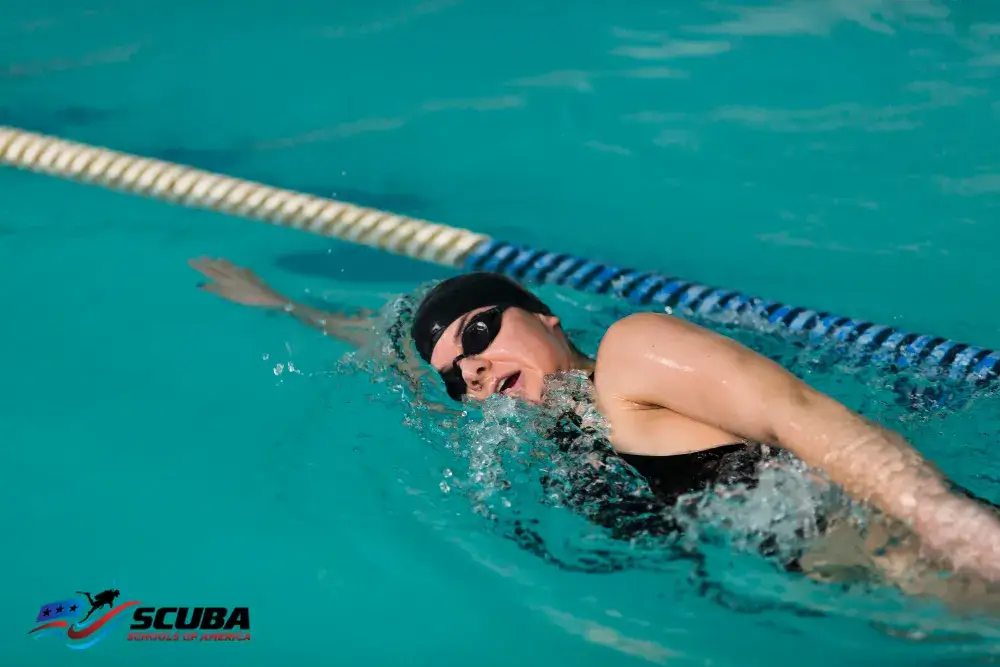
The front crawl, also known as the freestyle stroke, is one of the most widely practiced and efficient swimming techniques. It is not only ideal for full-body fitness but is also a keystroke in competitive swimming, including the Olympics.
Along with the butterfly, breaststroke, and backstroke, the front crawl is one of the four main strokes used in international competitions.
When performing the front crawl, the swimmer faces down in the water, maintaining a streamlined position. The legs execute a continuous flutter kick while the arms alternate between reaching forward above the water and pulling back underwater for propulsion.
This stroke is renowned for being the fastest of all competitive swimming styles and offers a moderate learning curve, making it accessible for most swimmers.
While casual swimmers may prefer the relaxing rhythm of the breaststroke, the front crawl is the preferred style for those interested in competitive swimming or open-water events.
It provides speed and efficiency, essential for racing or covering long distances. For added versatility, the backstroke can also be incorporated, especially when swimmers are comfortable tracking their direction in open water.
By mastering the front crawl, swimmers can enhance their fitness, performance, and overall enjoyment in both competitive and recreational settings.
How to Swim Front Crawl
The front crawl, often referred to as freestyle, is widely regarded as the fastest and most efficient swimming stroke. It’s a highly effective swimming technique that can help you burn up to 600 calories per hour while providing an excellent, low-impact workout for your entire body.
Continuous Smooth Movement
The front crawl relies heavily on your upper body, particularly the triceps and lats, to drive your movements. Maintaining a continuous arm action is essential to establish a smooth rhythm and minimize stress on your shoulder joints.
Arm and Hand Position
Proper arm positioning is critical for an efficient front crawl swimming technique.
- As your hand enters the water, keep your elbow slightly bent and positioned higher than your hand. Reach forward as far as possible on top of the water to maximize the pull distance. This extended reach enhances propulsion through the water.
- During the recovery phase, keep your arm relaxed, with a high elbow and fingers close to the water’s surface. This promotes a smoother and more efficient stroke.
The Kick
The kicking action in front crawl originates from the hips and engages the entire leg. Focus on maintaining a steady, alternating kick to support a streamlined stroke.
- Keep your knees slightly bent and your toes pointed, but avoid over-tensing your muscles.
- Relax your ankles to create a fluid kicking motion that complements the rest of your swimming technique.
Open Water Swimming
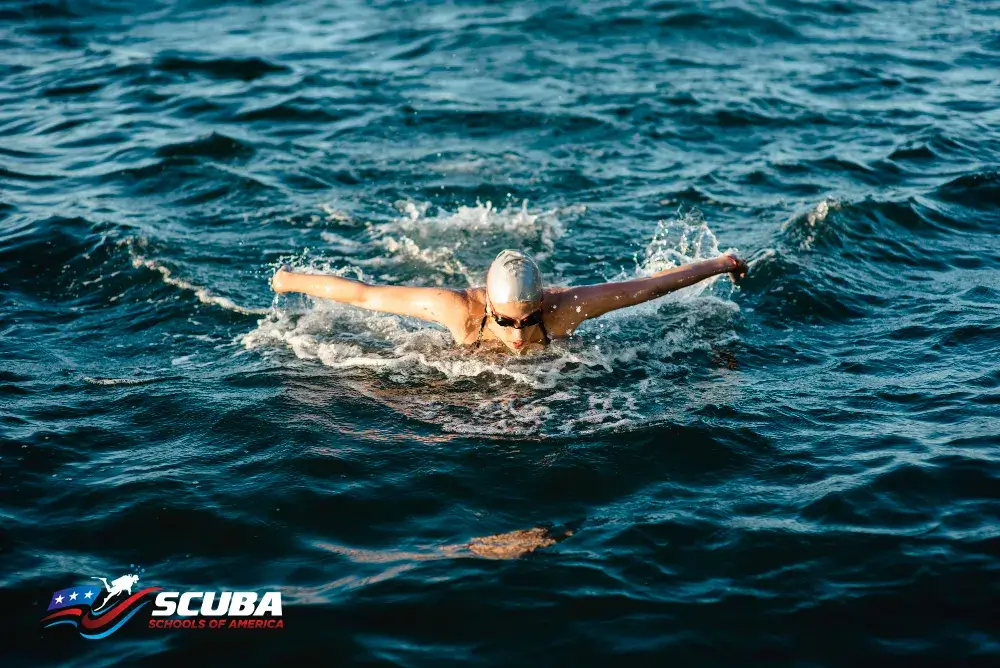
Swimming in open water introduces new and unpredictable challenges that require adaptation and skill. The front crawl, or freestyle, is the most popular swimming technique for oceans, lakes, and rivers due to its efficiency and speed.
Here are some top tips to help you improve your open water swimming technique and navigate challenging conditions:
1. Alternate Your Stroke Rate
In open water, adapting to the environment is essential. To optimize your swim:
- In choppy conditions, increase your stroke rate, using shorter and shallower strokes for better control.
- In calm waters, take longer, more powerful strokes to maximize propulsion and efficiency.
2. Use Sighting to Stay on Course
Open water swimming often causes you to drift off course due to currents, leading to wasted energy. Incorporate sighting into your swimming technique to maintain a straight path:
- Lift your head at regular intervals to spot a fixed point or landmark in the direction you’re swimming.
- Sighting helps you stay aligned and avoid unnecessary zigzagging.
3. Practice Bilateral Breathing
Most swimmers naturally favor breathing to one side during the front crawl. However, in open water, the ability to breathe comfortably on both sides is invaluable.
- Bilateral breathing allows you to adjust to changing conditions, such as wind direction or waves.
- This technique ensures you can breathe effectively regardless of the environmental elements.
Preparation for Open Water Swimming
Before heading out, always check the water temperature and conditions to ensure a safe swim. If swimming in cooler waters, take precautions such as:
- Wearing a swimsuit designed for open water swimming. For example, Zoggs’ silver-lined swimwear provides insulation and is environmentally friendly.
- Bring a hat and warm clothing to change into after your swim.
By incorporating these strategies and preparing appropriately, you can master open water swimming, improving both your confidence and enjoyment in this dynamic environment.
Master Your Swimming Skills with Scuba Schools of America
Swimming is not just an excellent form of exercise; it is a gateway to exploration and adventure. At Scuba Schools of America (SSA), we believe in taking swimming to the next level by empowering you to explore the world beneath the waves.
Whether you’re a beginner or a seasoned swimmer, our comprehensive programs are designed to improve your Swimming technique, expand your skills, and introduce you to the incredible underwater world.
With over 70% of the Earth’s surface covered by water, the opportunities to explore are limitless. At SSA, we provide expert training and guidance to help you become a confident swimmer and diver in diverse aquatic environments.
From pristine coral reefs teeming with marine life to mysterious shipwrecks and dramatic underwater landscapes, the ocean offers a unique sense of adventure that you can experience safely with the right training.
Our certified instructors are dedicated to teaching you the techniques and safety protocols necessary to thrive underwater. Whether you’re interested in snorkeling, scuba diving, or advanced certifications, SSA is your trusted partner in aquatic education.
Dive into your next adventure with confidence! Let Scuba Schools of America guide you on your journey. Whether you’re looking to enhance your swimming skills, explore scuba diving, or pursue advanced certifications, we’re here to support you every step of the way.
If you’d like more information, feel free to reach out to us via phone or email for personalized assistance.

